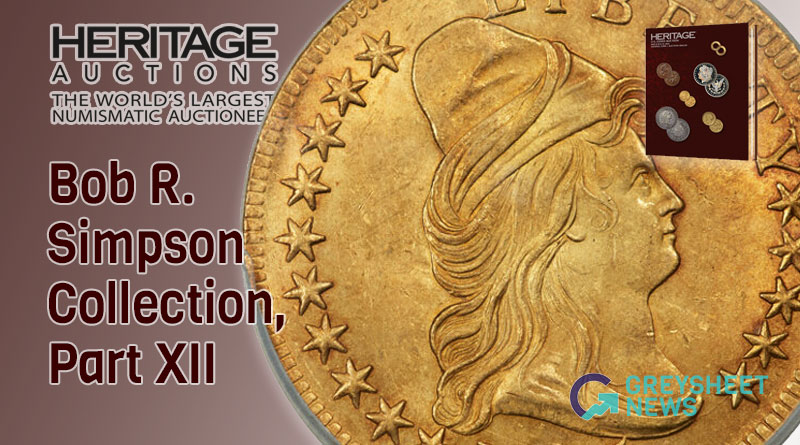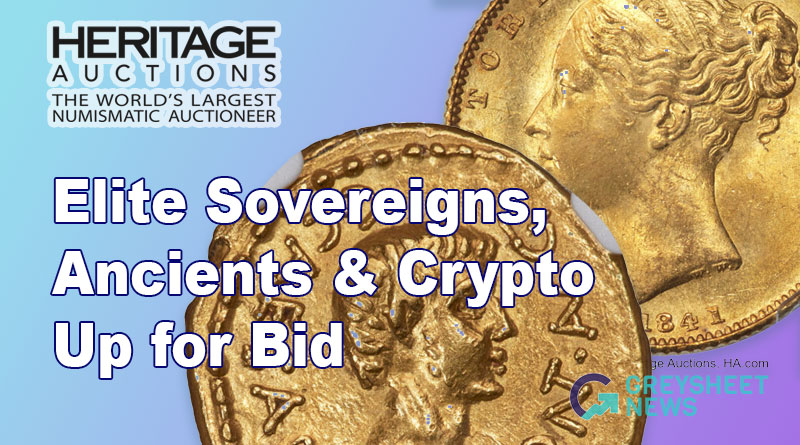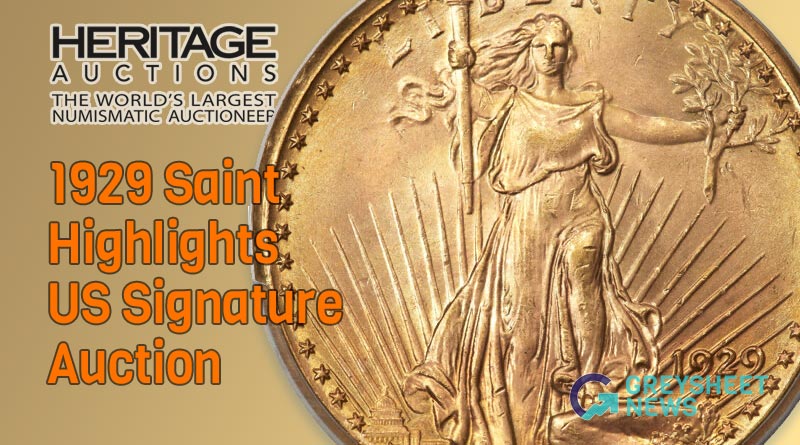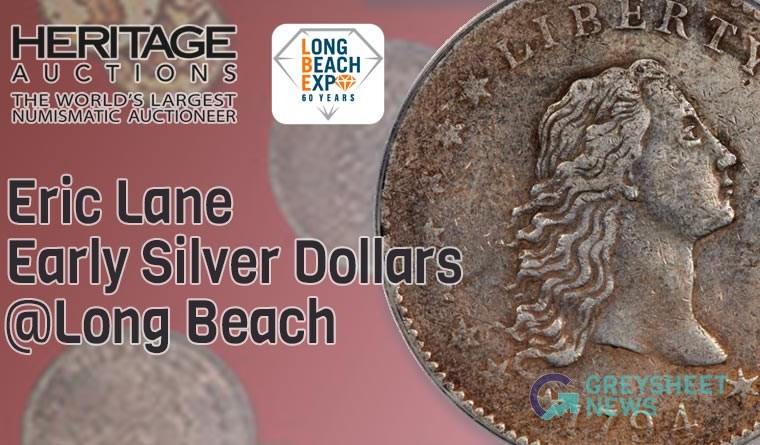Bob R. Simpson Collection, Part XII, Brings Elite Trophies To Heritage’s CSNS US Coins Auction
1795 13 Leaves Eagle and 1863 Judd-349 Ten among top attractions in May 8-12 event
DALLAS, Texas (April 18, 2024) — There is ample reason why people refer to a “gift that keeps on giving.”
In the case of collectors of American coins, one such gift is the Bob R. Simpson Collection. Considered one of the finest troves of US coins ever assembled, Heritage auction sales of specimens from the Simpson collection exceed $116 million, heading into Part XII.
The next installment — Important Selections from The Bob R. Simpson Collection, Part XII — will be among the top attractions in Heritage’s May 8-12 CSNS US Coins Signature® Auction.
Simpson’s collection includes elite sets and individual coins, some of which will be offered in this auction.
“Mr. Simpson really found a great balance between rarity and quality,” said Greg Rohan, President of Heritage Auctions. “Over the years, I’ve seen Mr. Simpson decline plenty of very, very rare coins, because they just lack special eye appeal, or particularly high quality. Conversely, I’ve seen him pass on many coins that were very high quality or exhibiting exceptional eye appeal, because they really weren’t inherently scarce… (He) practiced, really, connoisseurship, above any other collecting goals. By that I mean, most collectors work toward completion of a certain finite set… Mr. Simpson did complete some sets, but he never felt pressured or rushed to fill that hole that he needed.”
The Coinage Act of April 1792, sometimes called the Mint Act, laid the groundwork for the establishment of the United States Mint and a national coinage system. Based on the earlier work of Alexander Hamilton, the Mint Act identified the officers, their salaries and their duties, the denominations of gold, silver, and copper coins, the standard purity of gold and silver coins, and established the dollar as the official money of account for the United States. America’s first gold coins, including a 1795 13 Leaves Eagle, BD-1, MS64+ PCGS that is one of the highlights from the Simpson collection, were produced during the administration of Mint Director Henry William DeSaussure. This example is an exquisite near-Gem example of BD-1, documented as the first die variety of the eagle denomination.
Reaching the collecting market in this auction is an 1863 Ten Dollar, PR64 Cameo PCGS, CAC, Judd-349 that is a magnificent example representing the pinnacle of rarity in American numismatics. Just one specimen of this important pattern issue is known to collectors and it claims an unbroken pedigree back to its day of striking. Only a few numismatic issues — Judd-349 among them — can claim to be unique.
Also from Simpson’s collection is a spectacular Superb Gem 1913 Saint-Gaudens Double Eagle, PR67. Reports about the mintage of proof 1913 Saint-Gaudens double eagles can vary, depending on the source. The 2024 Guide Book lists the proof mintage as 58 pieces, while in his Saint-Gaudens Double Eagles as Illustrated by the Phillip H. Morse and Steven Duckor Collections, Roger W. Burdette notes that the “Deliveries 1911-1915” notebook/ledger at the Philadelphia Mint reported two deliveries totaling 88 pieces. Dannreuther reports a third delivery of 11 coins, bringing the total to 99 pieces. Curiously, records indicate only 58 examples were actually distributed. Whichever total is correct, the experts' estimates of the surviving population for the issue are in close agreement. PCGS CoinFacts estimates 40-45 examples survive today in all grades, while Burdette suggests 40 pieces are extant and Dannreuther believes 35-45 specimens still exist.
Unseen at auction for more than 80 years but available in this auction is an 1839 Gobrecht Dollar in Copper PR64 Red and Brown PCGS. This is the unique copper variant of the extremely rare (three known) Judd-108 restrikes in silver. An August 1941 auction catalog described it as “The only one known to exist. ... Excessively rare and unique.” Following that auction, it turned up in Abe Kosoff’s fixed price lists in the 1960s, but then fell into obscurity for decades.
Another standout from the Simpson collection is a 1797 BD-1 Eagle, MS61 PCGS, which is tied for the fifth-finest known example. The 1797 Small Eagle BD-1 eagles often are celebrated as major rarities, which supports Dannreuther’s estimate of just 55-65 known examples. This example is tied for the second-best PCGS-certified coin behind an MS62 example that was sold at Heritage Auctions in August 2023.
Beyond the Simpson collection, the auction is teeming with exceptional numismatic treasures, including a 1776 Continental Dollar, MS61 NGC. The Newman 1-C Continental dollar has long captured the interest of early American specialists and Colonial coins collectors, in part because of the misspelled “CURENCY” on the obverse. It ranks alongside two other pewter varieties, Newman 2-C and Newman 3-D, in availability and popularity. These varieties are more accessible than other variants of the issue, including four other Newman-variety Continental dollars considered formidable rarities, particularly those struck in silver or brass. Although no monetary denomination appears, American collectors are often captivated by this issue, in part because of the 1776 date that was so significant in the nation’s history … despite the fact that the debate over whether these coins were minted in Europe or America remains unresolved.
An 1861 Original Confederate Cent, PR63 PCGS is among the most sought-after issues in American numismatics. Many questions remain about Confederate cents, but what is known includes the fact that the total struck in early 1861 was estimated at just 16. The engraver, Robert Lovett, Jr., struck the coins clandestinely, but accidentally spent one in a Philadelphia tavern, leading to the discovery of the issue. As hostility grew, Lovett grew anxious about producing coins for the Confederacy; his concern was validated when President Abraham Lincoln signed legislation in July 1861 that made it illegal for Northern businessmen to engage in commerce with the Confederacy.
An 1879 Flowing Hair Stella, Judd-1635, PR66 Cameo CACG, is a stunning example of one of the most popular issues in American numismatics. Although technically a pattern, the 1879 Stella, which was named one of the 100 Greatest U.S. Coins, typically is collected as a trophy coin and type issue. The surviving population is in the hundreds, but there never are enough high-quality examples to meet the unending demand.
An 1833 Capped Head Left Half Eagle, MS65+ PCGS tops the Condition Census for the variety. The 1833 Capped Head Left half eagle is a landmark rarity in the series, and examples always are in demand. In addition to its popularity with series specialists, the 1833 half eagle represents the short-lived Reduced Diameter design type, making it a favorite selection of type collectors. This magnificent Plus-graded Gem is the finest-certified Mint State 1833 half eagle of any variety.
Images and information about all lots in the auction can be found at HA.com/1374.

Download the Greysheet app for access to pricing, news, events and your subscriptions.
Subscribe Now.
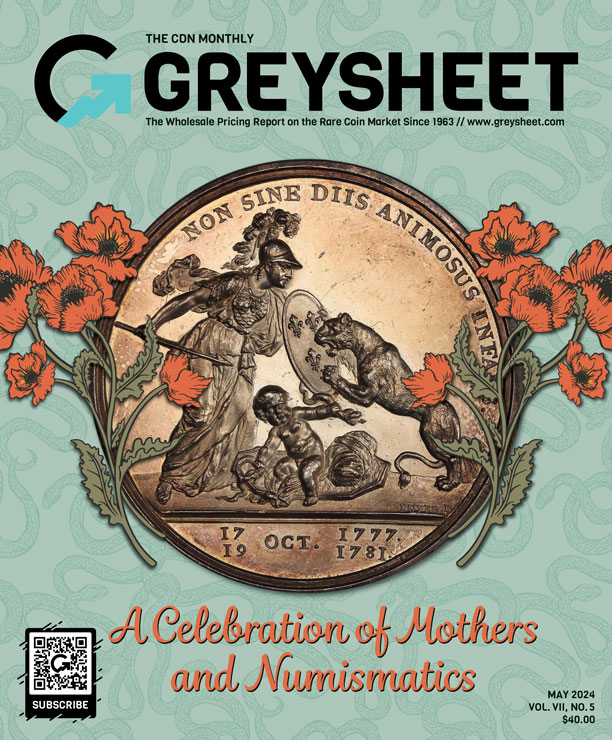
Subscribe to Monthly Greysheet for the industry's most respected pricing and to read more articles just like this.
Source: Heritage Auctions


